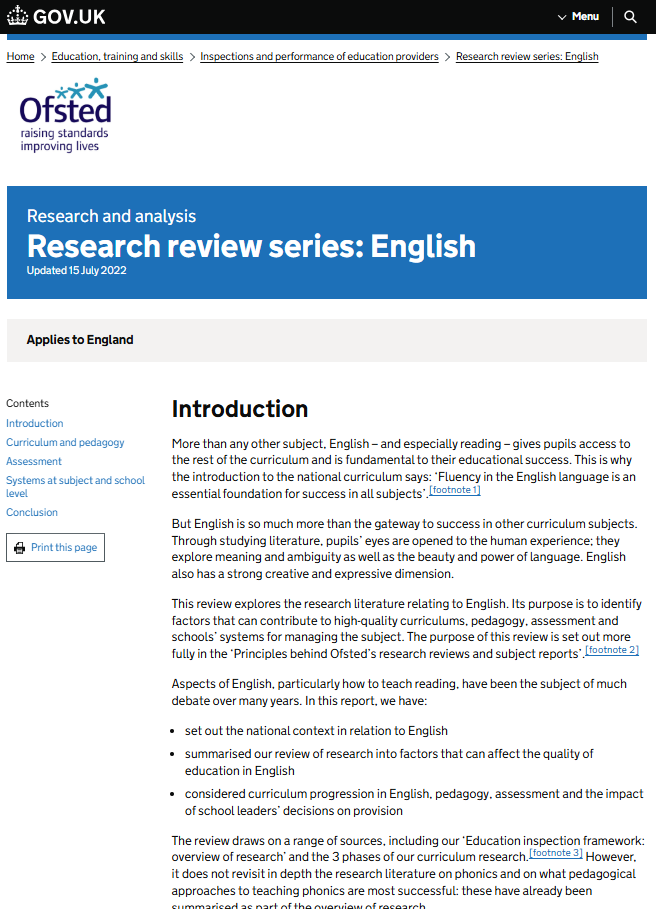Reflecting on an effective writing curriculum

The focus on the teaching of reading in schools for the last few years has been high following DfE guidance about teaching phonics and the Reading Framework publication in 2021. This focus has led to greater consistency in the teaching of reading and closing gaps, with a clearer focus on the aspects of reading that schools should consider in their vision and curriculum.
As schools have become more confident with their approaches to teaching reading, focus has moved back towards how they teach writing. I am often asked by leaders: 'How can I create an effective writing curriculum?', ‘What should my writing curriculum look like?’; ‘How can I bring my writing outcomes more in line with reading outcomes?’ ‘What is the most effective pedagogy?’ ‘How can I ensure that both aspects of writing are taught effectively?’ So where might you start, when refocusing on writing?
A well-planned curriculum vs a progression document
Good outcomes are based upon a clearly defined and well-planned curriculum and whilst there may be a progression document in place at school, there are significant differences between the two. A writing curriculum should encompass a clear context; key texts on which teaching will be based; planned independent outcomes; and most importantly the key learning and skills that will be taught across each year.
Typically, a progression document will outline what is expected by the end of each year by pupils, but it doesn’t break learning down into smaller manageable steps each term or half term, which help to ensure deeper learning and clear progression towards an end goal.
These smaller steps of learning can be defined by schools to make their curriculum bespoke and linked to planned outcomes. Mapping out these skills also supports teachers to see where and when learning is planned to keep teaching focused and linked to context. If well-planned, it may also allow teaching to consider ‘fewer things in greater depth’ across a year or key stage.

Balancing transcription and composition
When planning an effective writing curriculum, consideration must be given to both aspects of transcription and composition. As well as planning for a range of compositional skills to be included in fiction and non-fiction writing, this must be balanced with effective planning for, and teaching of, transcriptional skills. Research tells us that explicit teaching of spelling and handwriting should happen little and often, ideally daily for the youngest pupils.
The challenge for many schools is to determine when this explicit teaching takes place in the timetable, how to ensure this continues to remain a priority, and also what this teaching looks like. A spelling test is an assessment, not teaching. Pupils simply practising handwriting, without any teacher input about the process, leads to misconceptions and incorrect letter formation. Identifying how and when the teaching of key transcriptional skills takes place, adds strength to a writing curriculum and will ultimately improve outcomes for pupils.
An effective writing pedagogy

What does effective teaching of writing look like? Once there is a clearly planned curriculum in place, the next consideration is what the teaching of writing looks like to deliver these curricular aims. There is much research about what effective teaching of writing should look like.
1. The use of model texts with pupils.
It is important that reading and studying examples of the genre to be written takes place. Reading as a reader, then reading as a writer helps focus pupils on the impact of the writing and then unpick which techniques have been used to make it effective. Pupils can then apply this knowledge when writing own versions.
2. Immersing pupils in the text type.
Pupils benefit from being part of shared reading and book talk sessions which focus on the purpose for, and audience of the writing. There should be an emphasis on impact on the reader rather than simply going straight into listing features of the text type. Ofsted noted in their English research review: ‘This might lead to pupils using textual and language features without understanding why they are useful and what purposes they serve.’
3. Direct instruction and modelling.
Building clear opportunities into a writing unit for pupils to experience explicit teaching of writing through modelling, followed by extensive practice of short-focused tasks is effective practice. These lessons should be interspersed with clear feedback before pupils reach the point of applying what they have learned into independent outcomes.
4. Teaching grammar at the point of writing.
‘Research suggests that it can be effective for teachers to focus on the function and application of grammar within the context of writing.’ (Ofsted)
By teaching grammar in this way, teachers can emphasise the connections between linguistic features and the effect they can have on the reader. This can lead to pupils producing writing with a clear purpose and intention with features to reflect this, rather than ‘checklist’ writing.
Refocusing on your writing curriculum and your teaching pedagogy can be a daunting prospect. A strong curriculum is your best starting point. Our team can provide this guidance and support.
Ready to find out more?
Get in touch if you’d like to discuss writing in your school further.

